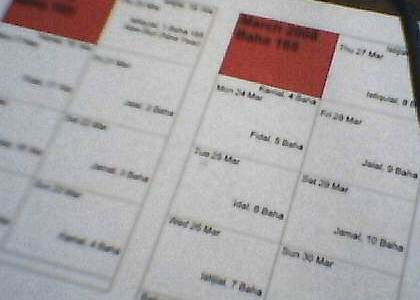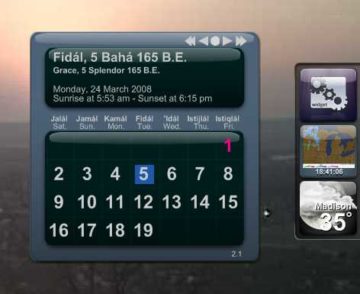5 Baha 165 BE (Baha’i Era)
Soundtrack in my head: Antonio Carlos Jobim, “Ela e Carioca”
 Recently, we Baha’is celebrated the New Year on the Baha’i calendar. It happened to be on the same day as Good Friday, which is highly unusual. The new year is timed roughly with the spring equinox. I have had a geek-fascination with the Baha’i calendar (also know as the Badi calendar) ever since rediscovering the Baha’i Faith last summer.
Recently, we Baha’is celebrated the New Year on the Baha’i calendar. It happened to be on the same day as Good Friday, which is highly unusual. The new year is timed roughly with the spring equinox. I have had a geek-fascination with the Baha’i calendar (also know as the Badi calendar) ever since rediscovering the Baha’i Faith last summer.
The Baha’i calendar is a solar calendar that has nineteen months of nineteen days each—totalling 361 days—and four or five extra days to round out the total number of days to either 365 or 366 depending on whether the year is a leap year or not.
The Báb, the founder of the Bábi religion (which was the forerunner of the Baha’i Faith) introduced the calendar, and he named each of the nineteen months after an attribute of God. Today is the 5th day of Baha, and the word “Baha” is Arabic for Splendor. Because the number of months and the number of days are equal, some users of the calendar will use the attributes of God to designate both the day and the month, so that the 5th day of Baha would be referred to as the Nur (Light) of Baha. The Baha’is time their feasts with the first day of each Baha’i month.
Nineteen years elapsed between when the Bab declared his mission in 1844 (equivalent to the year 1 in the Baha’i calendar) and when Baha’u’llah declared his mission in 1863. Less common uses of the Baha’i calendar involve designating a span of nineteen years as a “vahid” but so far, I’ve seen that rarely referenced.
For me, the number nineteen has personal significance. I chose the date of November 19, 2007 to declare myself a Baha’i, because it was nineteen years before in November 1988 that I was first introduced to the Baha’i Faith while a student at the University of Illinois at Urbana-Champaign. I decided not to go with the Faith back then for various personal reasons. But the U of I Baha’is gave me a book on the Faith, which, miraculously, stayed with me through almost a dozen moves, and was still sitting on my bookshelf when I opened it again in the summer of 2007.
Personally, I find it interesting that in the Year One of the Baha’i Calendar (1844) the Rochdale Pioneers founded what is considered by many to be the first successful co-op in the industrialized West. The Rochdale co-op and the Babis/Baha’is were very likely unaware of each other, and I don’t know how many Baha’is have embraced the co-op movement. But, speaking only for myself–I see a few parallels between the co-op movement and the Baha’i Faith. Cooperatives consist of people at the grassroots pooling their resources to provide a common good that might not otherwise be easily available—whether it’s food, shelter, or electricity. The Baha’i Faith, for its part, has no clergy and so local grassroots efforts are, for the most part, are the only thing driving the local Baha’i community.
Another interesting aspect of the Baha’i calendar is that the change of day is marked by sunset, rather than midnight. This is also true of the Hebrew and Islamic calendars. On one level, scheduling becomes a little tricky because the day ends and begins at a slightly different time each day. On the other hand, there is something precious about watching the sunset and having it signify the passing from one day to the next. It’s particularly special when watching the sun set into the new year, though in Madison, this year’s Naw Ruz (New Year) was cloudy so there was no sunset to watch.
 There is a neat little widget that I downloaded onto my computer that asks for the latitude and longitude coordinates of where I live, and, using that data, shows the exact date on the Baha’i calendar and shows the sunrise and sunset for that day.
There is a neat little widget that I downloaded onto my computer that asks for the latitude and longitude coordinates of where I live, and, using that data, shows the exact date on the Baha’i calendar and shows the sunrise and sunset for that day.
I decided to create my own little weekly calendar planner that incorporated both the Gregorian (modern) and Baha’i calendars. I desktop-published a bunch of calendar pages and put them in a three-ring binder designed to accommodate half size pages—5 1/2” by 8 1/2”, which is the size of most paper planners.
I also am experimenting with using the Baha’i months for my own personal planning. Around the beginning of each Baha’i month, I look at my things to do lists, critically evaluate them, and then generate new lists that I then put into the planner. I see nineteen-day intervals potentially being more useful than thirty-day intervals because the nineteen-day intervals make it harder for me to put off things until later in the month.
I also think using the Baha’i calendar like this is a way for me to tune in with God, an effort to align my planning with God’s planning. I’m only now experimenting with planning my time in this way. I recently learned that Tom Morey, a surfing pioneer and a Baha’i, used to stamp the Boogie Boards he invented with the Baha’i era date. I’m still very new to the Baha’i Faith, and I can’t say even for sure whether I will continue to be a Baha’i ten, twenty or thirty years from now. Nevertheless, I feel motivated to put the Baha’i dates on my blog, too in an effort to try to stay attuned with God…

Hello! I found your post when googling for something completely different (well, kind of; I googled "when should I declare myself a Baha’i, and got this!) I have just started learning about the calander, and I think it’s kind of neat, though I wonder if many people use the Badi calander as their main one, and I also wonder how your using it is working with ours. Thanks for an interesting read!P.S: I also think it was really neat that you declared 19 years after first hearing about the faith, that is pretty cool!
Thanks for your comments and history. I am trying to see if one can organize life by the Baha'i calendar and thus I liked your last paragraphs especially.